語言伺服器擴充套件指南
如您在程式設計式語言功能主題中所見,可以透過直接使用languages.* API 實現語言功能。然而,語言伺服器擴充套件提供了一種實現此類語言支援的替代方式。
本主題
- 解釋了語言伺服器擴充套件的優勢。
- 引導您使用
Microsoft/vscode-languageserver-node庫構建語言伺服器。您也可以直接跳轉到lsp-sample中的程式碼。
為什麼選擇語言伺服器?
語言伺服器是一種特殊的 Visual Studio Code 擴充套件,它為許多程式語言提供了編輯體驗。透過語言伺服器,您可以實現自動補全、錯誤檢查(診斷)、跳轉到定義以及 VS Code 支援的許多其他語言功能。
然而,在 VS Code 中實現語言功能支援時,我們發現了三個常見問題
首先,語言伺服器通常以其原生程式語言實現,這給將其與具有 Node.js 執行時的 VS Code 整合帶來了挑戰。
此外,語言功能可能佔用大量資源。例如,為了正確驗證檔案,語言伺服器需要解析大量檔案,為它們構建抽象語法樹並執行靜態程式分析。這些操作可能會導致大量的 CPU 和記憶體使用,我們需要確保 VS Code 的效能不受影響。
最後,將多種語言工具與多個程式碼編輯器整合可能需要付出巨大的努力。從語言工具的角度來看,它們需要適應具有不同 API 的程式碼編輯器。從程式碼編輯器的角度來看,它們不能期望語言工具提供任何統一的 API。這使得在 N 個程式碼編輯器中實現 M 種語言的語言支援成為 M * N 的工作量。
為了解決這些問題,Microsoft 指定了語言伺服器協議,該協議規範了語言工具和程式碼編輯器之間的通訊。這樣,語言伺服器可以用任何語言實現,並在自己的程序中執行以避免效能開銷,因為它們透過語言伺服器協議與程式碼編輯器通訊。此外,任何符合 LSP 的語言工具都可以與多個符合 LSP 的程式碼編輯器整合,任何符合 LSP 的程式碼編輯器都可以輕鬆支援多個符合 LSP 的語言工具。LSP 對語言工具提供商和程式碼編輯器供應商來說都是雙贏的!
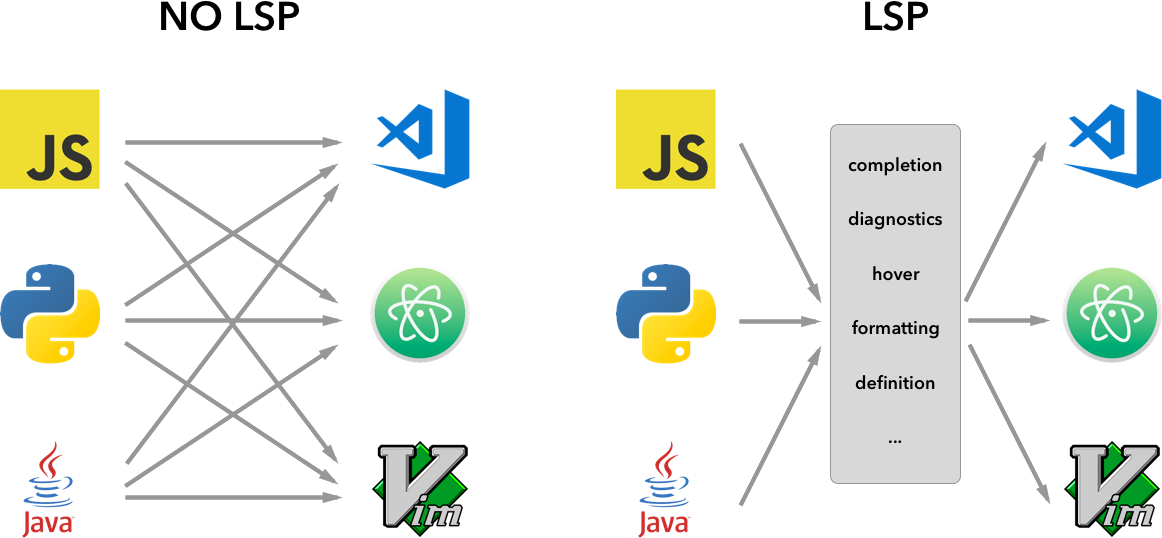
在本指南中,我們將
- 解釋如何使用提供的Node SDK在 VS Code 中構建語言伺服器擴充套件。
- 解釋如何執行、除錯、記錄和測試語言伺服器擴充套件。
- 為您指出一些關於語言伺服器的高階主題。
實現語言伺服器
概述
在 VS Code 中,語言伺服器由兩部分組成
- 語言客戶端:用 JavaScript / TypeScript 編寫的普通 VS Code 擴充套件。此擴充套件可以訪問所有VS Code 名稱空間 API。
- 語言伺服器:在單獨程序中執行的語言分析工具。
如上所述,在單獨程序中執行語言伺服器有兩個好處
- 只要分析工具能夠遵循語言伺服器協議與語言客戶端通訊,就可以用任何語言實現。
- 由於語言分析工具通常會佔用大量 CPU 和記憶體,因此在單獨程序中執行它們可以避免效能開銷。
這是 VS Code 執行兩個語言伺服器擴充套件的示意圖。HTML 語言客戶端和 PHP 語言客戶端是使用 TypeScript 編寫的普通 VS Code 擴充套件。它們各自例項化一個相應的語言伺服器並透過 LSP 與其通訊。儘管 PHP 語言伺服器是用 PHP 編寫的,但它仍然可以透過 LSP 與 PHP 語言客戶端通訊。
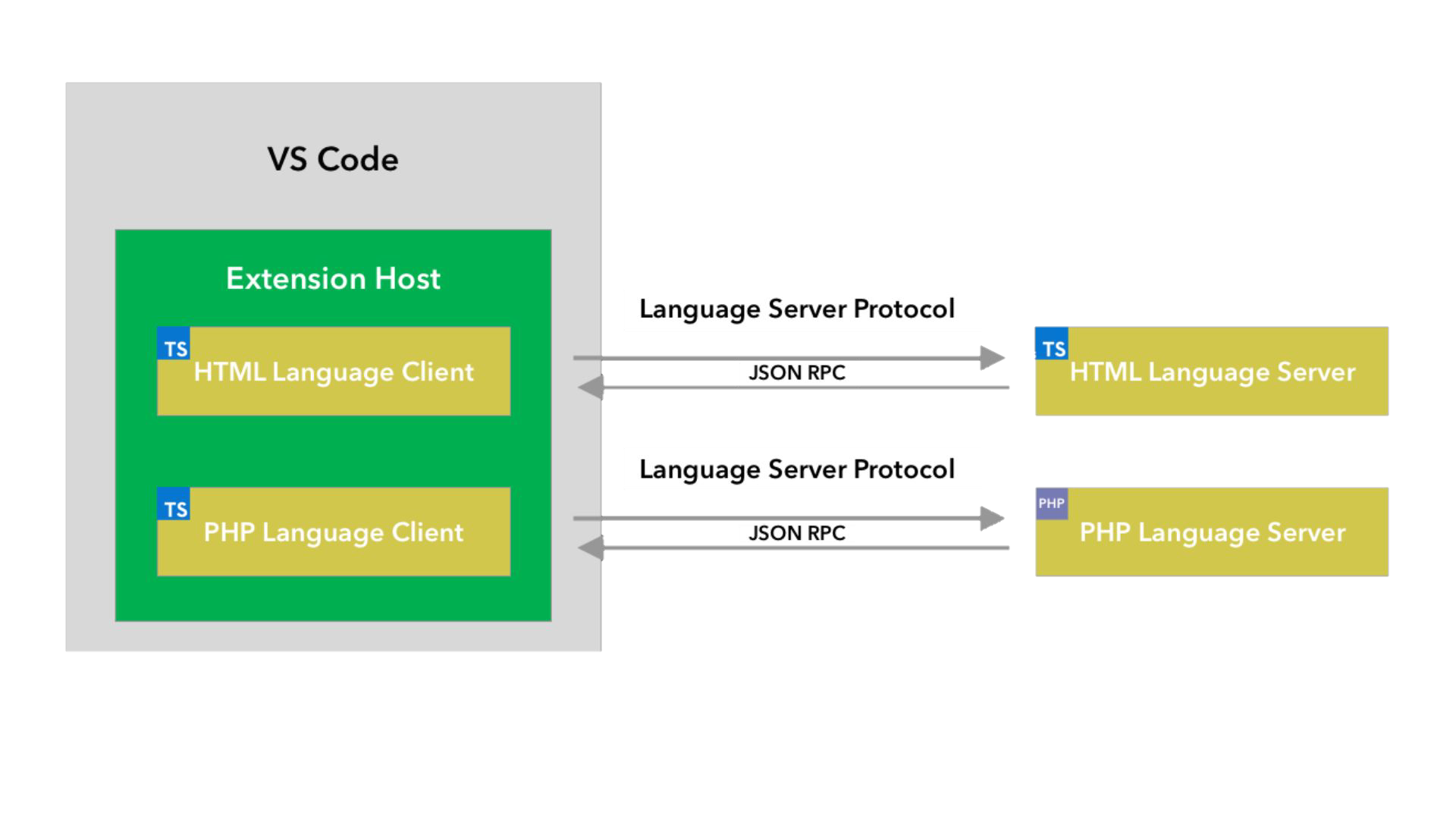
本指南將教您如何使用我們的Node SDK構建語言客戶端/伺服器。文件其餘部分假設您熟悉 VS Code 擴充套件 API。
LSP 示例 - 一個用於純文字檔案的簡單語言伺服器
讓我們構建一個簡單的語言伺服器擴充套件,它為純文字檔案實現自動補全和診斷功能。我們還將介紹客戶端/伺服器之間的配置同步。
如果您更喜歡直接檢視程式碼
- lsp-sample:本指南的詳細註釋原始碼。
- lsp-multi-server-sample:lsp-sample的一個詳細註釋的高階版本,它為每個工作區資料夾啟動一個不同的伺服器例項,以支援 VS Code 中的多根工作區功能。
克隆儲存庫Microsoft/vscode-extension-samples並開啟示例
> git clone https://github.com/microsoft/vscode-extension-samples.git
> cd vscode-extension-samples/lsp-sample
> npm install
> npm run compile
> code .
以上安裝了所有依賴項並打開了包含客戶端和伺服器程式碼的 lsp-sample 工作區。以下是 lsp-sample 結構的大致概述
.
├── client // Language Client
│ ├── src
│ │ ├── test // End to End tests for Language Client / Server
│ │ └── extension.ts // Language Client entry point
├── package.json // The extension manifest
└── server // Language Server
└── src
└── server.ts // Language Server entry point
解釋“語言客戶端”
讓我們首先看一下/package.json,它描述了語言客戶端的功能。有兩個有趣的章節
首先,檢視configuration部分
"configuration": {
"type": "object",
"title": "Example configuration",
"properties": {
"languageServerExample.maxNumberOfProblems": {
"scope": "resource",
"type": "number",
"default": 100,
"description": "Controls the maximum number of problems produced by the server."
}
}
}
此部分向 VS Code 貢獻了configuration設定。該示例將解釋這些設定如何在啟動時和每次設定更改時傳送到語言伺服器。
注意:如果您的擴充套件相容 VS Code 1.74.0 之前的版本,您必須在
/package.json的activationEvents欄位中宣告onLanguage:plaintext,以告訴 VS Code 在開啟純文字檔案(例如副檔名為.txt的檔案)時立即啟用擴充套件。"activationEvents": []
實際的語言客戶端原始碼和相應的package.json位於/client資料夾中。/client/package.json檔案中有趣的部分是它透過engines欄位引用了vscode擴充套件主機 API,並添加了對vscode-languageclient庫的依賴
"engines": {
"vscode": "^1.52.0"
},
"dependencies": {
"vscode-languageclient": "^7.0.0"
}
如前所述,客戶端被實現為一個普通的 VS Code 擴充套件,它可以訪問所有 VS Code 名稱空間 API。
以下是相應的 extension.ts 檔案的內容,它是 lsp-sample 擴充套件的入口
import * as path from 'path';
import { workspace, ExtensionContext } from 'vscode';
import {
LanguageClient,
LanguageClientOptions,
ServerOptions,
TransportKind
} from 'vscode-languageclient/node';
let client: LanguageClient;
export function activate(context: ExtensionContext) {
// The server is implemented in node
let serverModule = context.asAbsolutePath(path.join('server', 'out', 'server.js'));
// The debug options for the server
// --inspect=6009: runs the server in Node's Inspector mode so VS Code can attach to the server for debugging
let debugOptions = { execArgv: ['--nolazy', '--inspect=6009'] };
// If the extension is launched in debug mode then the debug server options are used
// Otherwise the run options are used
let serverOptions: ServerOptions = {
run: { module: serverModule, transport: TransportKind.ipc },
debug: {
module: serverModule,
transport: TransportKind.ipc,
options: debugOptions
}
};
// Options to control the language client
let clientOptions: LanguageClientOptions = {
// Register the server for plain text documents
documentSelector: [{ scheme: 'file', language: 'plaintext' }],
synchronize: {
// Notify the server about file changes to '.clientrc files contained in the workspace
fileEvents: workspace.createFileSystemWatcher('**/.clientrc')
}
};
// Create the language client and start the client.
client = new LanguageClient(
'languageServerExample',
'Language Server Example',
serverOptions,
clientOptions
);
// Start the client. This will also launch the server
client.start();
}
export function deactivate(): Thenable<void> | undefined {
if (!client) {
return undefined;
}
return client.stop();
}
解釋“語言伺服器”
注意: 從 GitHub 倉庫克隆的“伺服器”實現包含了最終的演練實現。要跟隨演練,您可以建立一個新的
server.ts或修改克隆版本的內容。
在示例中,伺服器也是用 TypeScript 實現並使用 Node.js 執行的。由於 VS Code 已經自帶 Node.js 執行時,因此除非您對執行時有特殊要求,否則無需提供自己的執行時。
語言伺服器的原始碼位於/server。伺服器的package.json檔案中有趣的部分是
"dependencies": {
"vscode-languageserver": "^7.0.0",
"vscode-languageserver-textdocument": "^1.0.1"
}
這將引入vscode-languageserver庫。
下面是一個伺服器實現,它使用提供的文字文件管理器,透過始終將增量差分從 VS Code 傳送到伺服器來同步文字文件。
import {
createConnection,
TextDocuments,
Diagnostic,
DiagnosticSeverity,
ProposedFeatures,
InitializeParams,
DidChangeConfigurationNotification,
CompletionItem,
CompletionItemKind,
TextDocumentPositionParams,
TextDocumentSyncKind,
InitializeResult
} from 'vscode-languageserver/node';
import { TextDocument } from 'vscode-languageserver-textdocument';
// Create a connection for the server, using Node's IPC as a transport.
// Also include all preview / proposed LSP features.
let connection = createConnection(ProposedFeatures.all);
// Create a simple text document manager.
let documents: TextDocuments<TextDocument> = new TextDocuments(TextDocument);
let hasConfigurationCapability: boolean = false;
let hasWorkspaceFolderCapability: boolean = false;
let hasDiagnosticRelatedInformationCapability: boolean = false;
connection.onInitialize((params: InitializeParams) => {
let capabilities = params.capabilities;
// Does the client support the `workspace/configuration` request?
// If not, we fall back using global settings.
hasConfigurationCapability = !!(
capabilities.workspace && !!capabilities.workspace.configuration
);
hasWorkspaceFolderCapability = !!(
capabilities.workspace && !!capabilities.workspace.workspaceFolders
);
hasDiagnosticRelatedInformationCapability = !!(
capabilities.textDocument &&
capabilities.textDocument.publishDiagnostics &&
capabilities.textDocument.publishDiagnostics.relatedInformation
);
const result: InitializeResult = {
capabilities: {
textDocumentSync: TextDocumentSyncKind.Incremental,
// Tell the client that this server supports code completion.
completionProvider: {
resolveProvider: true
}
}
};
if (hasWorkspaceFolderCapability) {
result.capabilities.workspace = {
workspaceFolders: {
supported: true
}
};
}
return result;
});
connection.onInitialized(() => {
if (hasConfigurationCapability) {
// Register for all configuration changes.
connection.client.register(DidChangeConfigurationNotification.type, undefined);
}
if (hasWorkspaceFolderCapability) {
connection.workspace.onDidChangeWorkspaceFolders(_event => {
connection.console.log('Workspace folder change event received.');
});
}
});
// The example settings
interface ExampleSettings {
maxNumberOfProblems: number;
}
// The global settings, used when the `workspace/configuration` request is not supported by the client.
// Please note that this is not the case when using this server with the client provided in this example
// but could happen with other clients.
const defaultSettings: ExampleSettings = { maxNumberOfProblems: 1000 };
let globalSettings: ExampleSettings = defaultSettings;
// Cache the settings of all open documents
let documentSettings: Map<string, Thenable<ExampleSettings>> = new Map();
connection.onDidChangeConfiguration(change => {
if (hasConfigurationCapability) {
// Reset all cached document settings
documentSettings.clear();
} else {
globalSettings = <ExampleSettings>(
(change.settings.languageServerExample || defaultSettings)
);
}
// Revalidate all open text documents
documents.all().forEach(validateTextDocument);
});
function getDocumentSettings(resource: string): Thenable<ExampleSettings> {
if (!hasConfigurationCapability) {
return Promise.resolve(globalSettings);
}
let result = documentSettings.get(resource);
if (!result) {
result = connection.workspace.getConfiguration({
scopeUri: resource,
section: 'languageServerExample'
});
documentSettings.set(resource, result);
}
return result;
}
// Only keep settings for open documents
documents.onDidClose(e => {
documentSettings.delete(e.document.uri);
});
// The content of a text document has changed. This event is emitted
// when the text document first opened or when its content has changed.
documents.onDidChangeContent(change => {
validateTextDocument(change.document);
});
async function validateTextDocument(textDocument: TextDocument): Promise<void> {
// In this simple example we get the settings for every validate run.
let settings = await getDocumentSettings(textDocument.uri);
// The validator creates diagnostics for all uppercase words length 2 and more
let text = textDocument.getText();
let pattern = /\b[A-Z]{2,}\b/g;
let m: RegExpExecArray | null;
let problems = 0;
let diagnostics: Diagnostic[] = [];
while ((m = pattern.exec(text)) && problems < settings.maxNumberOfProblems) {
problems++;
let diagnostic: Diagnostic = {
severity: DiagnosticSeverity.Warning,
range: {
start: textDocument.positionAt(m.index),
end: textDocument.positionAt(m.index + m[0].length)
},
message: `${m[0]} is all uppercase.`,
source: 'ex'
};
if (hasDiagnosticRelatedInformationCapability) {
diagnostic.relatedInformation = [
{
location: {
uri: textDocument.uri,
range: Object.assign({}, diagnostic.range)
},
message: 'Spelling matters'
},
{
location: {
uri: textDocument.uri,
range: Object.assign({}, diagnostic.range)
},
message: 'Particularly for names'
}
];
}
diagnostics.push(diagnostic);
}
// Send the computed diagnostics to VS Code.
connection.sendDiagnostics({ uri: textDocument.uri, diagnostics });
}
connection.onDidChangeWatchedFiles(_change => {
// Monitored files have change in VS Code
connection.console.log('We received a file change event');
});
// This handler provides the initial list of the completion items.
connection.onCompletion(
(_textDocumentPosition: TextDocumentPositionParams): CompletionItem[] => {
// The pass parameter contains the position of the text document in
// which code complete got requested. For the example we ignore this
// info and always provide the same completion items.
return [
{
label: 'TypeScript',
kind: CompletionItemKind.Text,
data: 1
},
{
label: 'JavaScript',
kind: CompletionItemKind.Text,
data: 2
}
];
}
);
// This handler resolves additional information for the item selected in
// the completion list.
connection.onCompletionResolve(
(item: CompletionItem): CompletionItem => {
if (item.data === 1) {
item.detail = 'TypeScript details';
item.documentation = 'TypeScript documentation';
} else if (item.data === 2) {
item.detail = 'JavaScript details';
item.documentation = 'JavaScript documentation';
}
return item;
}
);
// Make the text document manager listen on the connection
// for open, change and close text document events
documents.listen(connection);
// Listen on the connection
connection.listen();
新增一個簡單的驗證
要向伺服器新增文件驗證,我們向文字文件管理器新增一個監聽器,該監聽器在文字文件內容更改時被呼叫。然後由伺服器決定何時是驗證文件的最佳時機。在示例實現中,伺服器驗證純文字文件並標記所有使用全部大寫的單詞。相應的程式碼片段如下
// The content of a text document has changed. This event is emitted
// when the text document first opened or when its content has changed.
documents.onDidChangeContent(async change => {
let textDocument = change.document;
// In this simple example we get the settings for every validate run.
let settings = await getDocumentSettings(textDocument.uri);
// The validator creates diagnostics for all uppercase words length 2 and more
let text = textDocument.getText();
let pattern = /\b[A-Z]{2,}\b/g;
let m: RegExpExecArray | null;
let problems = 0;
let diagnostics: Diagnostic[] = [];
while ((m = pattern.exec(text)) && problems < settings.maxNumberOfProblems) {
problems++;
let diagnostic: Diagnostic = {
severity: DiagnosticSeverity.Warning,
range: {
start: textDocument.positionAt(m.index),
end: textDocument.positionAt(m.index + m[0].length)
},
message: `${m[0]} is all uppercase.`,
source: 'ex'
};
if (hasDiagnosticRelatedInformationCapability) {
diagnostic.relatedInformation = [
{
location: {
uri: textDocument.uri,
range: Object.assign({}, diagnostic.range)
},
message: 'Spelling matters'
},
{
location: {
uri: textDocument.uri,
range: Object.assign({}, diagnostic.range)
},
message: 'Particularly for names'
}
];
}
diagnostics.push(diagnostic);
}
// Send the computed diagnostics to VS Code.
connection.sendDiagnostics({ uri: textDocument.uri, diagnostics });
});
診斷提示和技巧
- 如果起始和結束位置相同,VS Code 將用波浪線在那個位置的單詞下劃線。
- 如果你想用波浪線劃到行尾,那麼將結束位置的字元設定為 Number.MAX_VALUE。
要執行語言伺服器,請執行以下步驟
- 按 ⇧⌘B (Windows, Linux Ctrl+Shift+B) 啟動構建任務。該任務會編譯客戶端和伺服器。
- 開啟**執行**檢視,選擇**啟動客戶端**啟動配置,然後按**開始除錯**按鈕,啟動一個額外的**擴充套件開發主機**VS Code 例項,該例項將執行擴充套件程式碼。
- 在根資料夾中建立一個
test.txt檔案並貼上以下內容
TypeScript lets you write JavaScript the way you really want to.
TypeScript is a typed superset of JavaScript that compiles to plain JavaScript.
ANY browser. ANY host. ANY OS. Open Source.
然後,“擴充套件開發主機”例項將顯示如下
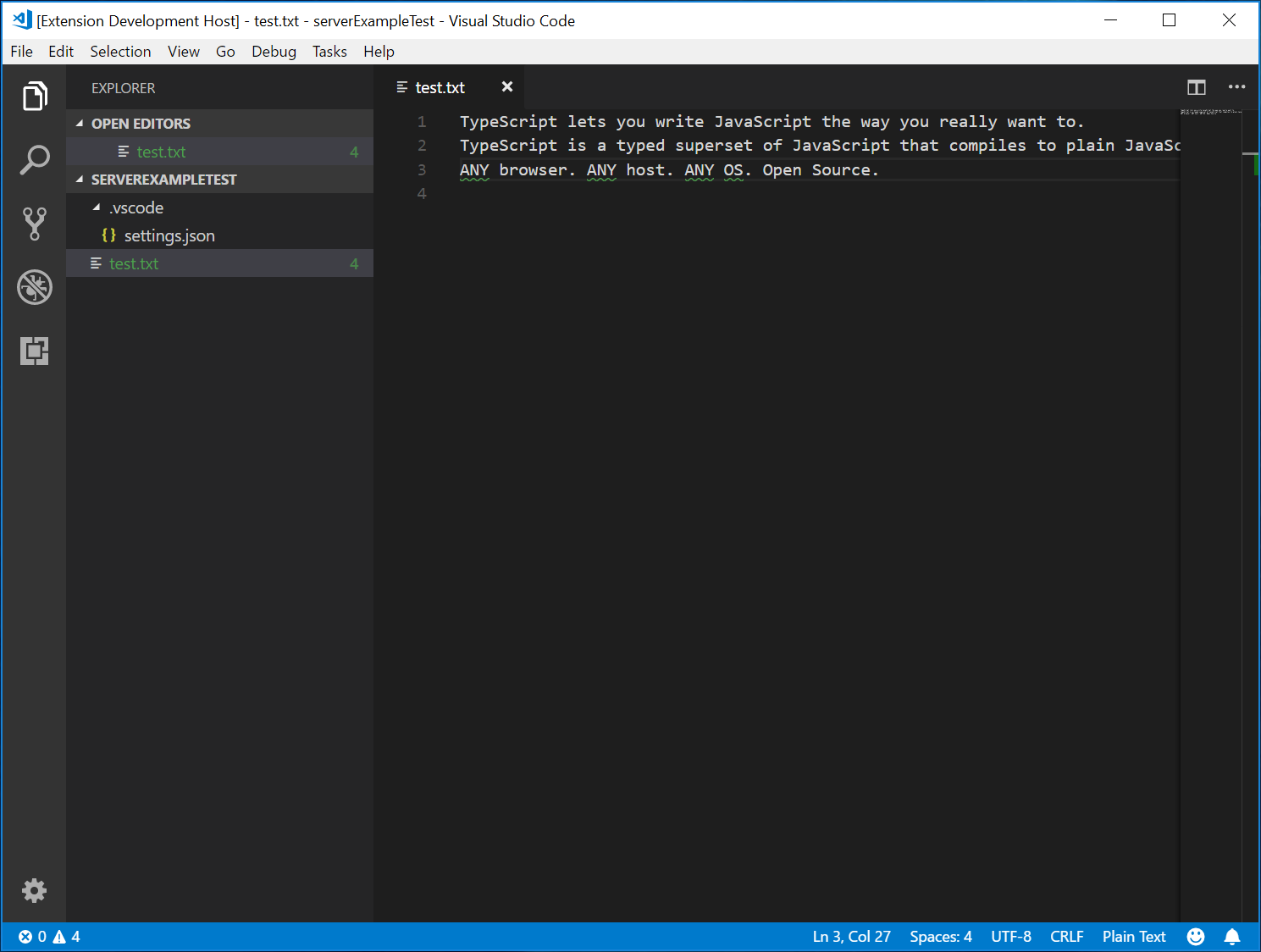
同時除錯客戶端和伺服器
除錯客戶端程式碼就像除錯普通擴充套件一樣簡單。在客戶端程式碼中設定一個斷點,然後按 F5 除錯擴充套件。
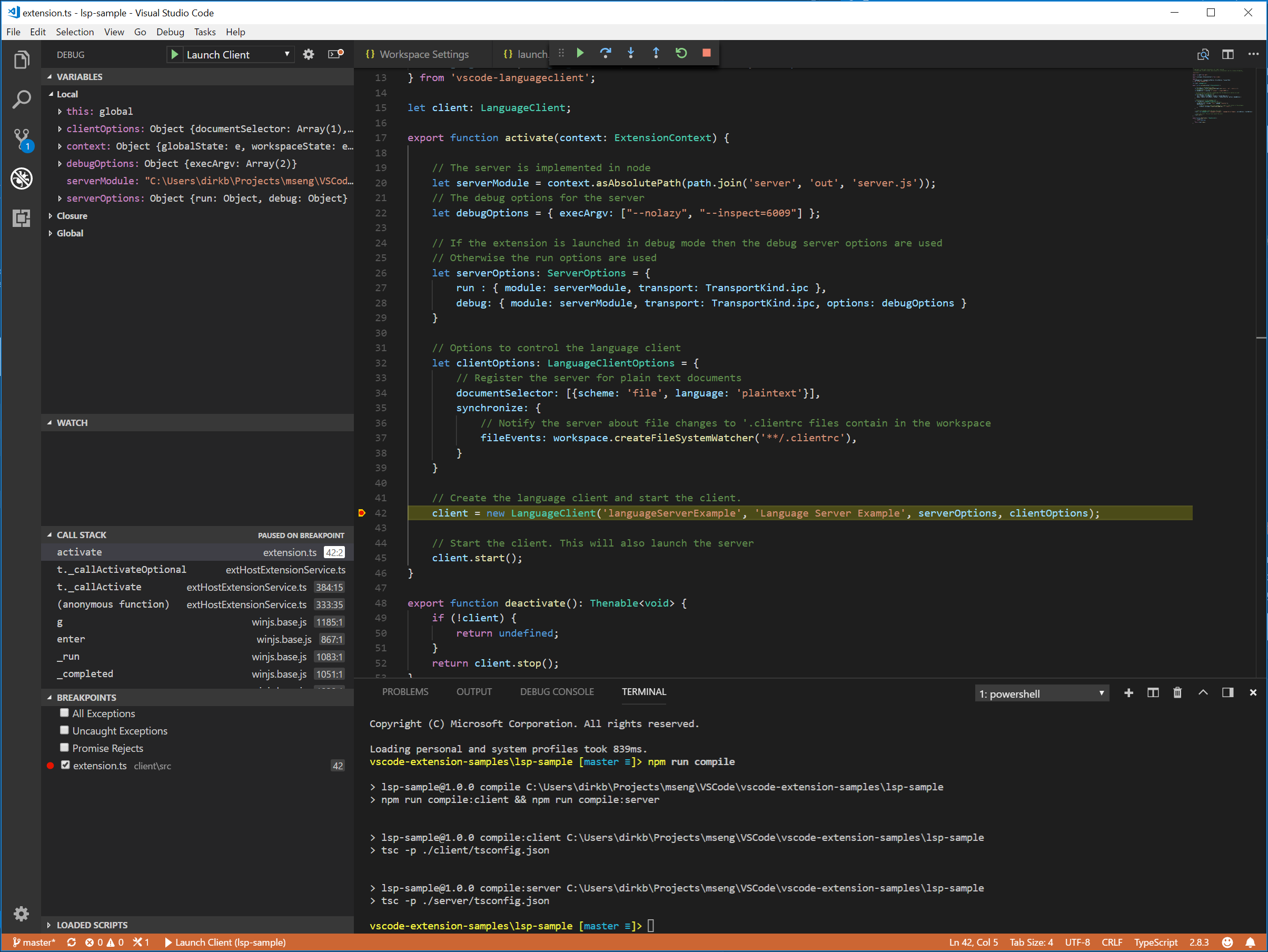
由於伺服器是由擴充套件(客戶端)中執行的LanguageClient啟動的,我們需要將偵錯程式附加到正在執行的伺服器。為此,切換到**執行和除錯**檢視,選擇**附加到伺服器**啟動配置,然後按F5。這會將偵錯程式附加到伺服器。
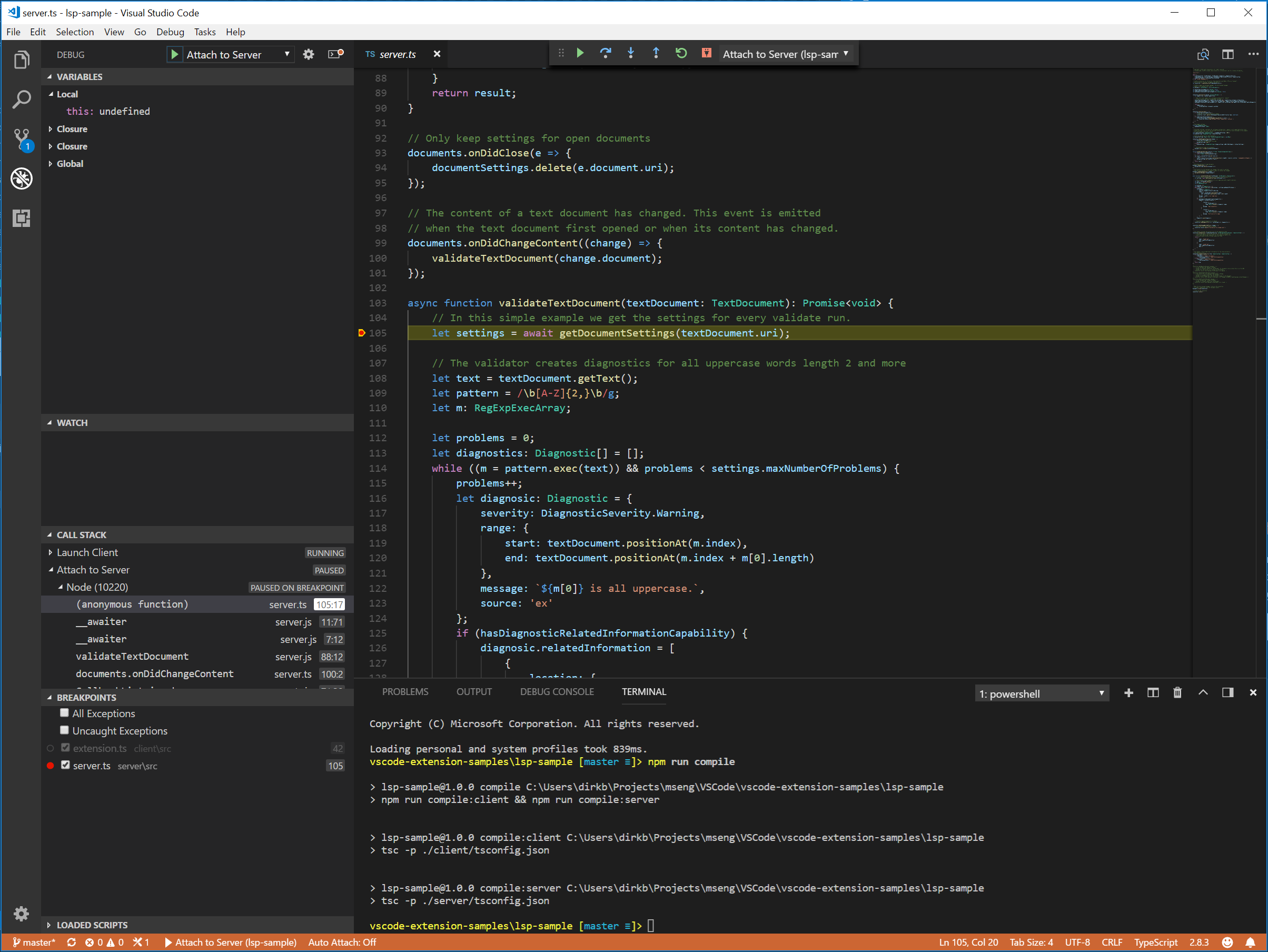
語言伺服器的日誌支援
如果您正在使用vscode-languageclient實現客戶端,您可以指定一個設定[langId].trace.server,它指示客戶端將語言客戶端/伺服器之間的通訊記錄到語言客戶端name的一個通道中。
對於**lsp-sample**,您可以設定此設定:"languageServerExample.trace.server": "verbose"。現在轉到“Language Server Example”通道。您應該會看到日誌
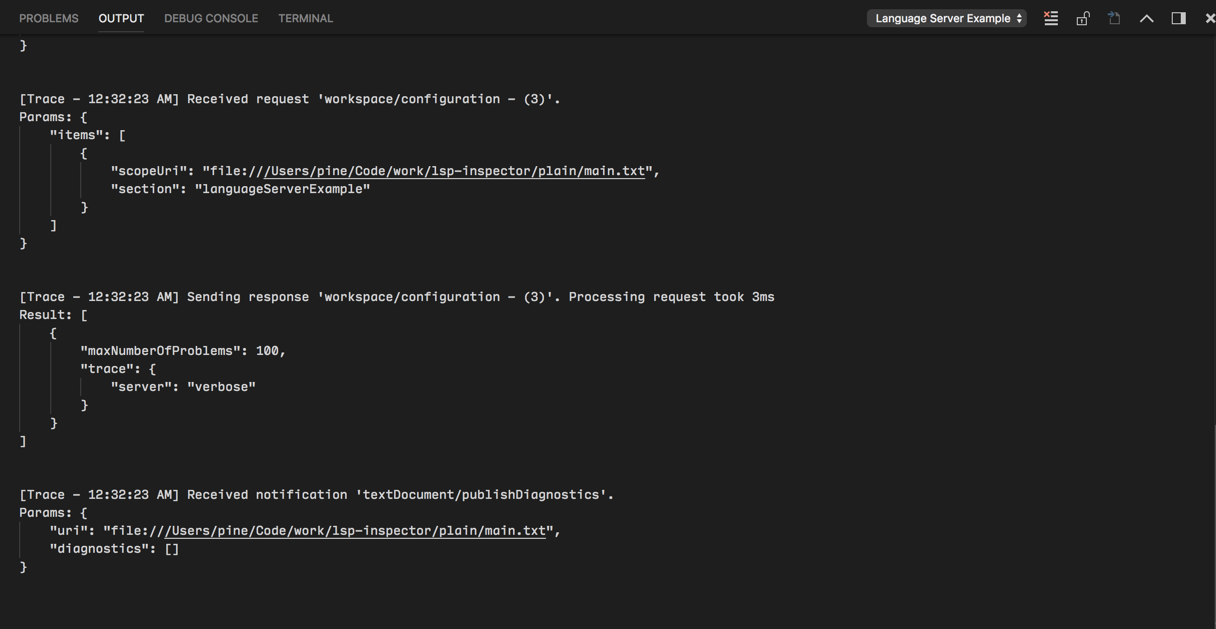
在伺服器中使用配置設定
在編寫擴充套件的客戶端部分時,我們已經定義了一個設定來控制報告的最大問題數量。我們還在伺服器端編寫了程式碼來從客戶端讀取這些設定
function getDocumentSettings(resource: string): Thenable<ExampleSettings> {
if (!hasConfigurationCapability) {
return Promise.resolve(globalSettings);
}
let result = documentSettings.get(resource);
if (!result) {
result = connection.workspace.getConfiguration({
scopeUri: resource,
section: 'languageServerExample'
});
documentSettings.set(resource, result);
}
return result;
}
現在我們只需要在伺服器端監聽配置更改,如果設定發生更改,就重新驗證開啟的文字文件。為了能夠重用文件更改事件處理的驗證邏輯,我們將程式碼提取到一個 validateTextDocument 函式中,並修改程式碼以遵守 maxNumberOfProblems 變數
async function validateTextDocument(textDocument: TextDocument): Promise<void> {
// In this simple example we get the settings for every validate run.
let settings = await getDocumentSettings(textDocument.uri);
// The validator creates diagnostics for all uppercase words length 2 and more
let text = textDocument.getText();
let pattern = /\b[A-Z]{2,}\b/g;
let m: RegExpExecArray | null;
let problems = 0;
let diagnostics: Diagnostic[] = [];
while ((m = pattern.exec(text)) && problems < settings.maxNumberOfProblems) {
problems++;
let diagnostic: Diagnostic = {
severity: DiagnosticSeverity.Warning,
range: {
start: textDocument.positionAt(m.index),
end: textDocument.positionAt(m.index + m[0].length)
},
message: `${m[0]} is all uppercase.`,
source: 'ex'
};
if (hasDiagnosticRelatedInformationCapability) {
diagnostic.relatedInformation = [
{
location: {
uri: textDocument.uri,
range: Object.assign({}, diagnostic.range)
},
message: 'Spelling matters'
},
{
location: {
uri: textDocument.uri,
range: Object.assign({}, diagnostic.range)
},
message: 'Particularly for names'
}
];
}
diagnostics.push(diagnostic);
}
// Send the computed diagnostics to VS Code.
connection.sendDiagnostics({ uri: textDocument.uri, diagnostics });
}
配置更改的處理是透過向連線新增配置更改通知處理程式來完成的。相應的程式碼如下所示
connection.onDidChangeConfiguration(change => {
if (hasConfigurationCapability) {
// Reset all cached document settings
documentSettings.clear();
} else {
globalSettings = <ExampleSettings>(
(change.settings.languageServerExample || defaultSettings)
);
}
// Revalidate all open text documents
documents.all().forEach(validateTextDocument);
});
再次啟動客戶端並將設定更改為最多報告 1 個問題,結果如下所示
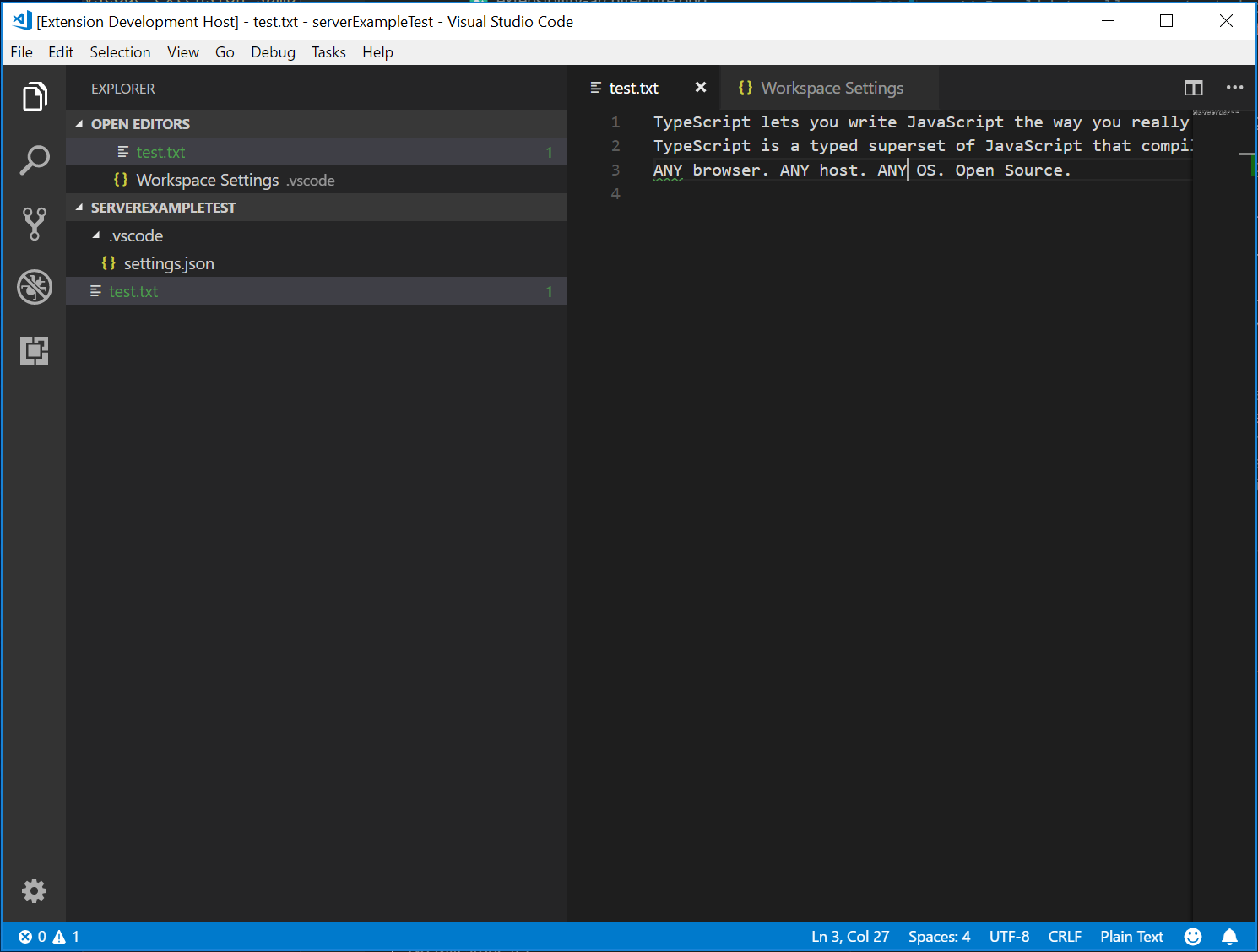
新增額外的語言功能
語言伺服器通常實現的首個有趣功能是文件驗證。從這個意義上講,即使是一個 linter 也算作語言伺服器,並且在 VS Code 中,linter 通常作為語言伺服器實現(例如,請參閱eslint和jshint)。但語言伺服器的功能不止於此。它們可以提供程式碼補全、查詢所有引用或跳轉到定義。下面的示例程式碼將程式碼補全新增到伺服器中。它建議了“TypeScript”和“JavaScript”這兩個詞。
// This handler provides the initial list of the completion items.
connection.onCompletion(
(_textDocumentPosition: TextDocumentPositionParams): CompletionItem[] => {
// The pass parameter contains the position of the text document in
// which code complete got requested. For the example we ignore this
// info and always provide the same completion items.
return [
{
label: 'TypeScript',
kind: CompletionItemKind.Text,
data: 1
},
{
label: 'JavaScript',
kind: CompletionItemKind.Text,
data: 2
}
];
}
);
// This handler resolves additional information for the item selected in
// the completion list.
connection.onCompletionResolve(
(item: CompletionItem): CompletionItem => {
if (item.data === 1) {
item.detail = 'TypeScript details';
item.documentation = 'TypeScript documentation';
} else if (item.data === 2) {
item.detail = 'JavaScript details';
item.documentation = 'JavaScript documentation';
}
return item;
}
);
data欄位用於在解析處理程式中唯一標識一個補全項。資料屬性對協議是透明的。由於底層訊息傳遞協議是基於 JSON 的,因此資料欄位應只包含可以序列化為 JSON 和從 JSON 反序列化的資料。
剩下的就是告訴 VS Code 伺服器支援程式碼補全請求。為此,請在初始化處理程式中標記相應的功能
connection.onInitialize((params): InitializeResult => {
...
return {
capabilities: {
...
// Tell the client that the server supports code completion
completionProvider: {
resolveProvider: true
}
}
};
});
下面的螢幕截圖顯示了在純文字檔案上執行的已完成程式碼
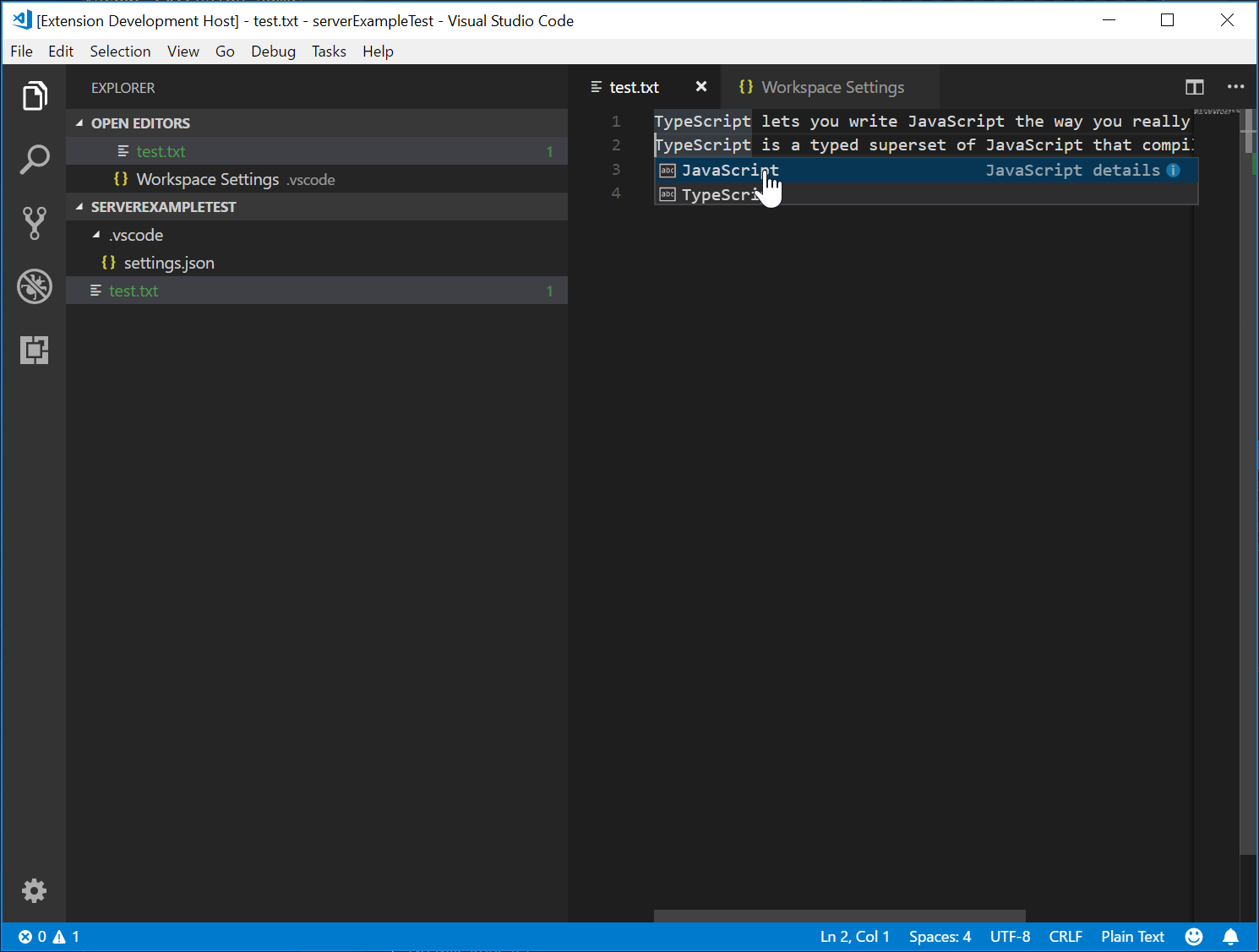
測試語言伺服器
為了建立一個高質量的語言伺服器,我們需要構建一個覆蓋其功能的良好測試套件。測試語言伺服器有兩種常見方法
- 單元測試:如果您想透過模擬傳送給語言伺服器的所有資訊來測試語言伺服器中的特定功能,這會很有用。VS Code 的HTML / CSS / JSON 語言伺服器採用這種測試方法。LSP npm 模組也使用這種方法。請參閱此處,瞭解一些使用 npm 協議模組編寫的單元測試。
- 端到端測試:這類似於VS Code 擴充套件測試。這種方法的優點是它透過例項化一個帶有工作區的 VS Code 例項、開啟檔案、啟用語言客戶端/伺服器並執行VS Code 命令來執行測試。如果您有難以或無法模擬的檔案、設定或依賴項(例如
node_modules),這種方法更優越。流行的Python擴展采用這種測試方法。
可以在您選擇的任何測試框架中進行單元測試。這裡我們描述如何對語言伺服器擴充套件進行端到端測試。
開啟.vscode/launch.json,您可以找到一個E2E測試目標
{
"name": "Language Server E2E Test",
"type": "extensionHost",
"request": "launch",
"runtimeExecutable": "${execPath}",
"args": [
"--extensionDevelopmentPath=${workspaceRoot}",
"--extensionTestsPath=${workspaceRoot}/client/out/test/index",
"${workspaceRoot}/client/testFixture"
],
"outFiles": ["${workspaceRoot}/client/out/test/**/*.js"]
}
如果執行此除錯目標,它將啟動一個以 client/testFixture 為活動工作區的 VS Code 例項。然後 VS Code 將繼續執行 client/src/test 中的所有測試。作為除錯提示,您可以在 client/src/test 的 TypeScript 檔案中設定斷點,它們將被命中。
讓我們看一下 completion.test.ts 檔案
import * as vscode from 'vscode';
import * as assert from 'assert';
import { getDocUri, activate } from './helper';
suite('Should do completion', () => {
const docUri = getDocUri('completion.txt');
test('Completes JS/TS in txt file', async () => {
await testCompletion(docUri, new vscode.Position(0, 0), {
items: [
{ label: 'JavaScript', kind: vscode.CompletionItemKind.Text },
{ label: 'TypeScript', kind: vscode.CompletionItemKind.Text }
]
});
});
});
async function testCompletion(
docUri: vscode.Uri,
position: vscode.Position,
expectedCompletionList: vscode.CompletionList
) {
await activate(docUri);
// Executing the command `vscode.executeCompletionItemProvider` to simulate triggering completion
const actualCompletionList = (await vscode.commands.executeCommand(
'vscode.executeCompletionItemProvider',
docUri,
position
)) as vscode.CompletionList;
assert.ok(actualCompletionList.items.length >= 2);
expectedCompletionList.items.forEach((expectedItem, i) => {
const actualItem = actualCompletionList.items[i];
assert.equal(actualItem.label, expectedItem.label);
assert.equal(actualItem.kind, expectedItem.kind);
});
}
在這個測試中,我們
- 啟用擴充套件。
- 使用 URI 和位置執行命令
vscode.executeCompletionItemProvider以模擬補全觸發。 - 將返回的補全項與我們預期的補全項進行斷言。
讓我們深入瞭解一下 activate(docURI) 函式。它定義在 client/src/test/helper.ts 中
import * as vscode from 'vscode';
import * as path from 'path';
export let doc: vscode.TextDocument;
export let editor: vscode.TextEditor;
export let documentEol: string;
export let platformEol: string;
/**
* Activates the vscode.lsp-sample extension
*/
export async function activate(docUri: vscode.Uri) {
// The extensionId is `publisher.name` from package.json
const ext = vscode.extensions.getExtension('vscode-samples.lsp-sample')!;
await ext.activate();
try {
doc = await vscode.workspace.openTextDocument(docUri);
editor = await vscode.window.showTextDocument(doc);
await sleep(2000); // Wait for server activation
} catch (e) {
console.error(e);
}
}
async function sleep(ms: number) {
return new Promise(resolve => setTimeout(resolve, ms));
}
在啟用部分,我們
- 使用
{publisher.name}.{extensionId}獲取擴充套件,如package.json中定義。 - 開啟指定文件,並在活動文字編輯器中顯示它。
- 暫停 2 秒,以確保語言伺服器已例項化。
準備就緒後,我們可以執行與每個語言功能對應的VS Code 命令,並對返回結果進行斷言。
還有一個測試涵蓋了我們剛剛實現的診斷功能。請在 client/src/test/diagnostics.test.ts 中檢視。
高階主題
到目前為止,本指南涵蓋了
- 語言伺服器和語言伺服器協議的簡要概述。
- VS Code 中語言伺服器擴充套件的架構
- lsp-sample 擴充套件,以及如何開發/除錯/檢查/測試它。
本指南中無法容納一些更高階的主題。我們將提供指向這些資源的連結,以供進一步學習語言伺服器開發。
額外的語言伺服器功能
除了程式碼補全之外,以下語言功能目前在語言伺服器中受支援
- 文件高亮:高亮顯示文字文件中所有“相等”的符號。
- 懸停:提供文字文件中選定符號的懸停資訊。
- 簽名幫助:提供文字文件中選定符號的簽名幫助。
- 轉到定義:提供文字文件中選定符號的轉到定義支援。
- 轉到型別定義:提供文字文件中選定符號的轉到型別/介面定義支援。
- 轉到實現:提供文字文件中選定符號的轉到實現定義支援。
- 查詢引用:查詢文字文件中選定符號的所有專案範圍引用。
- 列出文件符號:列出文字文件中定義的所有符號。
- 列出工作區符號:列出所有專案範圍符號。
- 程式碼操作:計算要執行的命令(通常是美化/重構),針對給定的文字文件和範圍。
- 程式碼透鏡:計算給定文字文件的程式碼透鏡統計資訊。
- 文件格式化:包括整個文件、文件範圍和輸入時格式化。
- 重新命名:專案範圍的符號重新命名。
- 文件連結:計算和解析文件中的連結。
- 文件顏色:計算並解析文件中的顏色,以便在編輯器中提供顏色選擇器。
程式語言功能主題描述了上述每種語言功能,並提供瞭如何透過語言伺服器協議或直接使用擴充套件的擴充套件性 API 來實現它們的指導。
增量文字文件同步
該示例使用 vscode-languageserver 模組提供的簡單文字文件管理器來同步 VS Code 和語言伺服器之間的文件。
這有兩個缺點
- 由於整個文字文件的內容重複傳送到伺服器,傳輸了大量資料。
- 如果使用現有的語言庫,此類庫通常支援增量文件更新,以避免不必要的解析和抽象語法樹建立。
因此,協議也支援增量文件同步。
要使用增量文件同步,伺服器需要安裝三個通知處理程式
- onDidOpenTextDocument:當文字文件在 VS Code 中開啟時呼叫。
- onDidChangeTextDocument:當文字文件內容在 VS Code 中更改時呼叫。
- onDidCloseTextDocument:當文字文件在 VS Code 中關閉時呼叫。
下面是一個程式碼片段,演示瞭如何將這些通知處理程式掛接到連線上以及如何在初始化時返回正確的功能
connection.onInitialize((params): InitializeResult => {
...
return {
capabilities: {
// Enable incremental document sync
textDocumentSync: TextDocumentSyncKind.Incremental,
...
}
};
});
connection.onDidOpenTextDocument((params) => {
// A text document was opened in VS Code.
// params.uri uniquely identifies the document. For documents stored on disk, this is a file URI.
// params.text the initial full content of the document.
});
connection.onDidChangeTextDocument((params) => {
// The content of a text document has change in VS Code.
// params.uri uniquely identifies the document.
// params.contentChanges describe the content changes to the document.
});
connection.onDidCloseTextDocument((params) => {
// A text document was closed in VS Code.
// params.uri uniquely identifies the document.
});
/*
Make the text document manager listen on the connection
for open, change and close text document events.
Comment out this line to allow `connection.onDidOpenTextDocument`,
`connection.onDidChangeTextDocument`, and `connection.onDidCloseTextDocument` to handle the events
*/
// documents.listen(connection);
直接使用 VS Code API 實現語言功能
雖然語言伺服器有很多優點,但它們並不是擴充套件 VS Code 編輯功能的唯一選擇。在您想為某種文件新增一些簡單的語言功能的情況下,可以考慮使用 vscode.languages.register[LANGUAGE_FEATURE]Provider 作為一個選項。
這是一個使用vscode.languages.registerCompletionItemProvider為純文字檔案新增一些片段作為補全的completions-sample。
更多說明 VS Code API 用法的示例可以在https://github.com/microsoft/vscode-extension-samples找到。
語言伺服器的容錯解析器
大多數情況下,編輯器中的程式碼是不完整且語法不正確的,但開發人員仍然期望自動補全和其他語言功能能夠正常工作。因此,語言伺服器需要一個容錯解析器:解析器從部分完整的程式碼中生成有意義的 AST,語言伺服器根據 AST 提供語言功能。
當我們改進 VS Code 中的 PHP 支援時,我們意識到官方 PHP 解析器不是容錯的,不能直接在語言伺服器中重用。因此,我們開發了 Microsoft/tolerant-php-parser,並留下了詳細的說明,這可能會幫助需要實現容錯解析器的語言伺服器作者。
常見問題
當我嘗試連線到伺服器時,出現“無法連線到執行時程序(5000 毫秒後超時)”?
如果嘗試附加偵錯程式時伺服器未執行,您將看到此超時錯誤。客戶端啟動語言伺服器,因此請確保您已啟動客戶端以使伺服器執行。如果客戶端斷點干擾伺服器啟動,您可能還需要停用它們。
我已經閱讀了本指南和LSP 規範,但我仍然有一些未解決的問題。我可以在哪裡獲得幫助?
請在https://github.com/microsoft/language-server-protocol上開一個 issue。